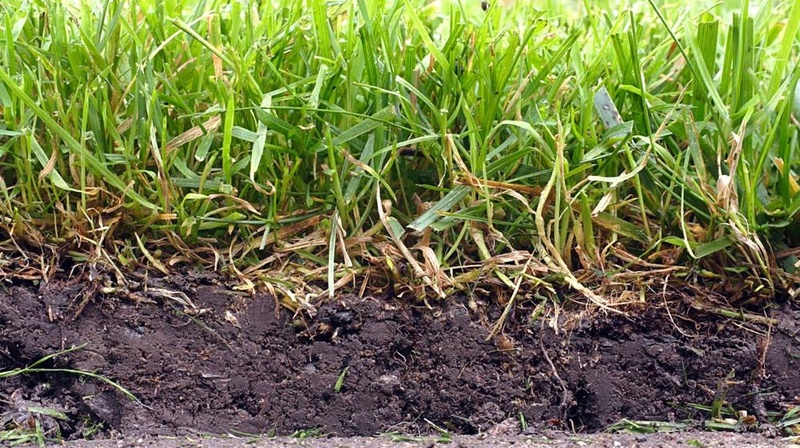
The Thing About Thatch
Thatch is a layer of organic matter between the base of grass blades and the soil. Layers of thatch thicker than one inch prevent air, water, and nutrients from reaching roots in the soil. They can be removed with a power rake or vertical mower.
If your lawn grass is St. Augustine, hybrid Bermuda, seashore paspalum, or zoysia, you probably know about thatch. These four Florida turf grasses are particularly prone to developing it.
What is Thatch?
Turf grass with no thatch consists of blades that go down almost to the soil. Turf grass with thatch contains a layer of organic matter between the base of the green blades and the soil. This layer is straw-colored or brown and is a mixture of things: dead shoots, stems, and roots plus live shoots, stems, and roots. Lignin, a compound, is also a significant part of thatch.
Thatch builds up when normal organic debris is not broken down. Some grass species are more prone than others to develop thatch layers because they produce a lot of stem tissue such as rhizomes or stolons (runners). Thatch may also build up when grass is growing in soil that contains low amounts of thatch-decomposing microorganisms.
Is Thatch Bad For Grass?
It depends on how much thatch is present in the grass. A thin layer—half an inch or less—is beneficial because of its insulating properties. Additionally, from a human use standpoint, a thin layer of thatch in grass gives the turf a little cushion for walking on or playing sports on.
The benefits of thatch disappear when the layer is more than an inch thick. Air, water, nutrients, and fertilizer are not able to get to the soil and the roots. Roots in the thatch are susceptible to drying out as the thatch heats up. Colonies of pests as well as various fungi find thatch a welcoming environment.
Turf with a thick layer of thatch is tricky to mow. Unless mowing height is adjusted to compensate for the thatch layer, mower wheels will sink and the deck will lower, cutting too much of the healthy lawn on top.
How to Remove Thatch
When thatch has reached a thickness of an inch or more, it should be removed. This can be somewhat of a project involving specialized tools.
Vertical mowers are designed specifically for thatch removal. Vertical mowers have evenly spaced blades that are perpendicular to the turf and move in an up-and-down plane (as opposed to regular rotary mowers whose blades move on a horizontal plane). They slice into the thatch, simultaneously removing it and cultivating the soil underneath.
Vertical mowing done improperly can kill grass, so care should be taken when using this machine. Homeowners may consider hiring a reputable lawn care company that has experience and knowledge about doing the job safely.
Power raking is another way to remove thatch. Power rakes have steel tines that revolve and loosen debris in turf. They do not cut into turf as vertical mowers do.
Preventing Thatch
Homeowners can manage or prevent thatch by mowing properly, not overusing fertilizer, and caring for the soil beneath such that it promotes robust decomposition. Topdressing turf with sand will also control thatch.